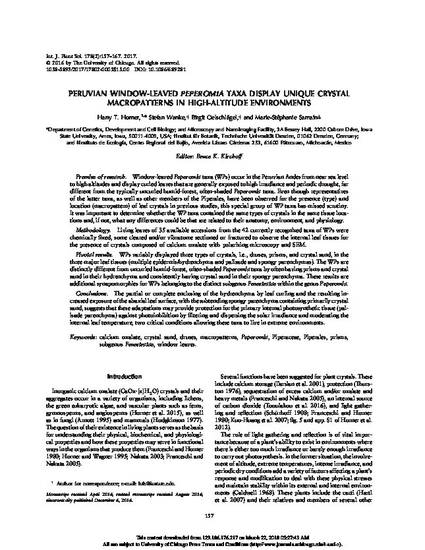
Article
Peruvian Window-Leaved Peperomia Taxa Display Unique Crystal Macropatterns in High-Altitude Environments
International Journal of Plant Sciences
Document Type
Article
Disciplines
Publication Version
Published Version
Publication Date
2-1-2017
DOI
10.1086/689281
Abstract
Premise of research. Window-leaved Peperomia taxa (WPs) occur in the Peruvian Andes from near sea level to high altitudes and display curled leaves that are generally exposed to high irradiance and periodic drought, far different from the typically uncurled humid-forest, often-shaded Peperomia taxa. Even though representatives of the latter taxa, as well as other members of the Piperales, have been observed for the presence (type) and location (macropattern) of leaf crystals in previous studies, this special group of WP taxa has missed scrutiny. It was important to determine whether the WP taxa contained the same types of crystals in the same tissue locations and, if not, what any differences could be that are related to their anatomy, environment, and physiology.
Methodology. Living leaves of 35 available accessions from the 42 currently recognized taxa of WPs were chemically fixed, some cleared and/or vibratome sectioned or fractured to observe the internal leaf tissues for the presence of crystals composed of calcium oxalate with polarizing microscopy and SEM.
Pivotal results. WPs variably displayed three types of crystals, i.e., druses, prisms, and crystal sand, in the three major leaf tissues (multiple epidermis/hydrenchyma and palisade and spongy parenchymas). The WPs are distinctly different from uncurled humid-forest, often-shaded Peperomia taxa by often having prisms and crystal sand in their hydrenchyma and consistently having crystal sand in their spongy parenchyma. These results are additional synapomorphies for WPs belonging to the distinct subgenus Fenestratae within the genus Peperomia.
Conclusions. The partial or complete enclosing of the hydrenchyma by leaf curling and the resulting increased exposure of the abaxial leaf surface, with the subtending spongy parenchyma containing primarily crystal sand, suggests that these adaptations may provide protection for the primary internal photosynthetic tissue (palisade parenchyma) against photoinhibition by filtering and dispersing the solar irradiance and moderating the internal leaf temperature, two critical conditions allowing these taxa to live in extreme environments.
Copyright Owner
The University of Chicago
Copyright Date
2016
Language
en
File Format
application/pdf
Citation Information
Harry T. Horner, Stefan Wanke, Birgit Oelschlägel and Marie-Stéphanie Samain. "Peruvian Window-Leaved Peperomia Taxa Display Unique Crystal Macropatterns in High-Altitude Environments" International Journal of Plant Sciences Vol. 178 Iss. 2 (2017) p. 157 - 167 Available at: http://works.bepress.com/harry-horner/101/

This article is published as Horner, Harry T., Stefan Wanke, Birgit Oelschlägel, and Marie-Stéphanie Samain. "Peruvian Window-Leaved Peperomia Taxa Display Unique Crystal Macropatterns in High-Altitude Environments." International Journal of Plant Sciences 178, no. 2 (2017): 157-167. doi: 10.1086/689281. Posted with permission.